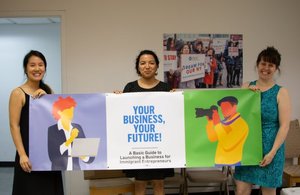In Conversation with New York Immigration Coalition

This month, Pratt Center in partnership with New York Immigration Coalition (NYIC), released “Your Business, Your Future: A guide to launching a business for immigrant entrepreneurs.” Pratt Center’s Sydney Céspedes who managed the project, recently sat down with Meredith Fortin, Director of Immigration Services Support at NYIC, and Jennifer So, Manager of Immigration Services Support at NYIC, to discuss how this resource came about and what entrepreneurs and service providers can expect from the guide.
Sydney: Who is this resource for and why was it created?
Meredith: The reason we ultimately produced this guide was seeing how the Trump administration was attacking people based on their immigration status or identity. NYIC began responding on a really broad front, but one thing we wanted to focus on was the economic piece--creating ways to help folks develop their skills, their resources, and their capacity to be anchors in their communities. Out of that came this set of resources for immigrant entrepreneurs. We were thinking not just about people who say they’re entrepreneurs but also people who essentially run a business, but don’t actually think of themselves as business owners, or are too intimidated to formalize their business. It can be mystifying to navigate through so many different government services so we wanted to produce a guide to help demystify that process and help people see themselves as entrepreneurs.
Sydney: So, what’s in the guide? How does it work?
Jennifer: This guide walks you through all the decisions you have to make about what your business will look like. Based on each individual's needs, it outlines all the administrative boxes you’re going to have to tick off, and the documentation you’ll need as you go through the process. By breaking down these requirements, it makes it less scary to people who may feel like they’re not in a position to start a business. It also has an excellent set of resources at the back for people who want to know more or get further assistance.
Meredith: I recently had a conversation with a service provider who works with immigrant entrepreneurs. They thought the guide was amazing because they often meet with people to talk about the requirements and decisions that have to be made, but it’s a lot to digest. The fact that, at the end of a long and complex meeting, they could hand over a guide for the person to review on their own time is so valuable. It makes service providers' jobs so much easier.
Sydney: So, it’s not just for immigrant communities in New York, but also for the providers serving them. What would you say was the biggest challenge in creating this resource?
Meredith: Practically speaking, it was challenging to make sure we had the right readers looking at all our information and picking up on small things we may have missed. We wanted to strike the right balance between approachable, general information and technically accurate information. We didn’t want to go too far into the weeds and create something that wasn’t appealing to a reader, but we also had to explain things in some depth because this stuff is really important. It was helpful to navigate the project with Pratt Center, who has such a great lens for what this kind of resource should look like and how to tie it together cohesively.
Sydney: What are your thoughts on how urban planning and policy professionals can better support immigrant communities?
Meredith: At the heart of any decision about how our communities should look or be resourced, or who is in a community and what their needs are, is the question of what power do these communities have. The immigrant community is increasingly in a place where it needs all the access to power it can get. We should be asking who has access to what resources, and whether those resources are responseive to what the community needs. Are we even asking those questions?
Jennifer: I would add that having power for immigrant communities often comes down to language access. We know through our Key to the City program how important language access is, and that was a priority when it came to this guide: ensuring that we represented the languages of populations we’re hoping to reach. Language leads to comprehension and comprehension translates to concrete power. That’s why we translated this guide into nine different languages: Arabic, Bengali, Urdu, Russian, Korean, English, Spanish, French, and Mandarin Chinese.
Sydney: Where can folks get their hands on the guide?
Meredith: It’s available to download in multiple languages at NYIC.org and at Pratt Center’s website. Hard copies will also be available at all of our Key to the City events.